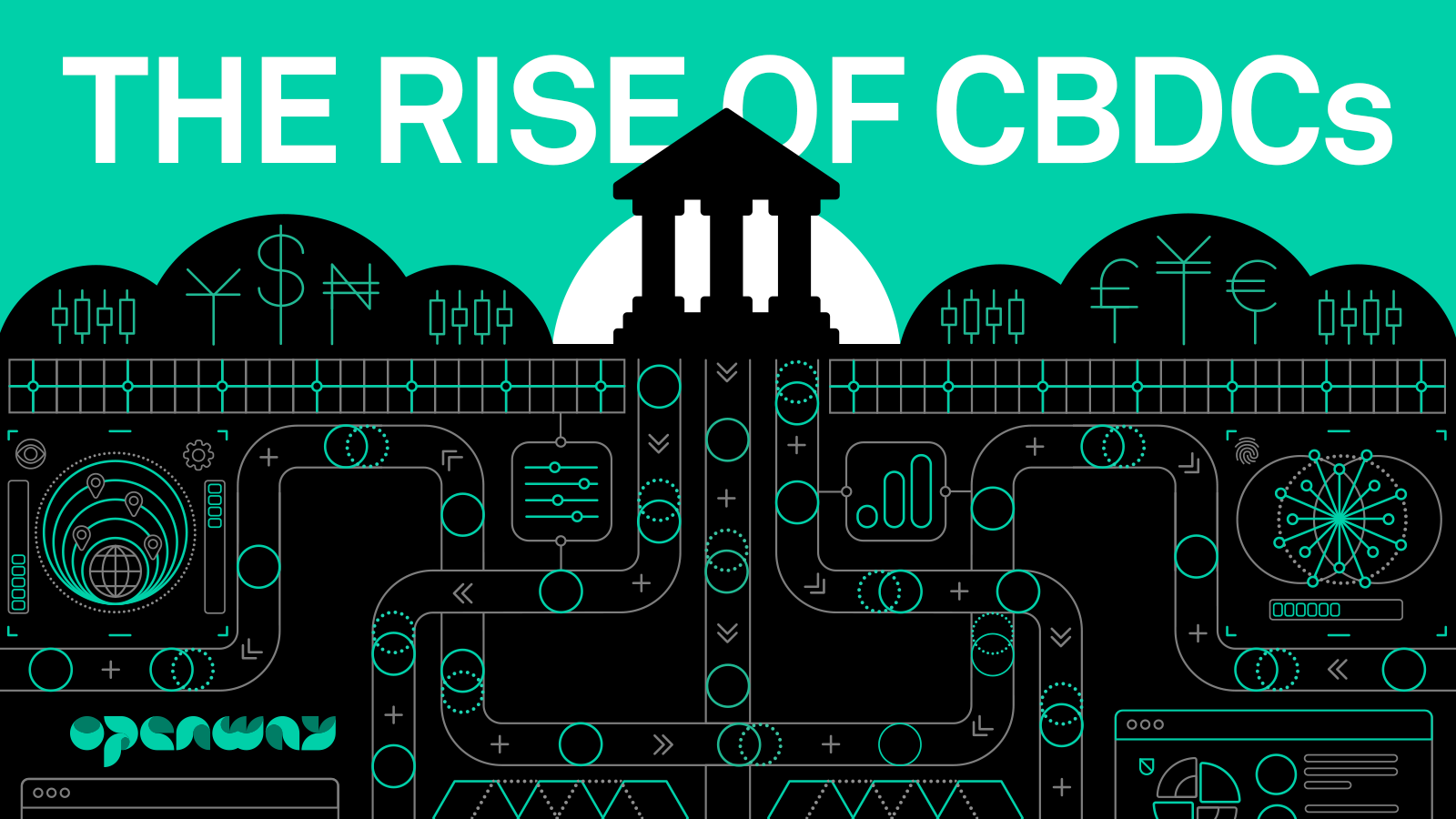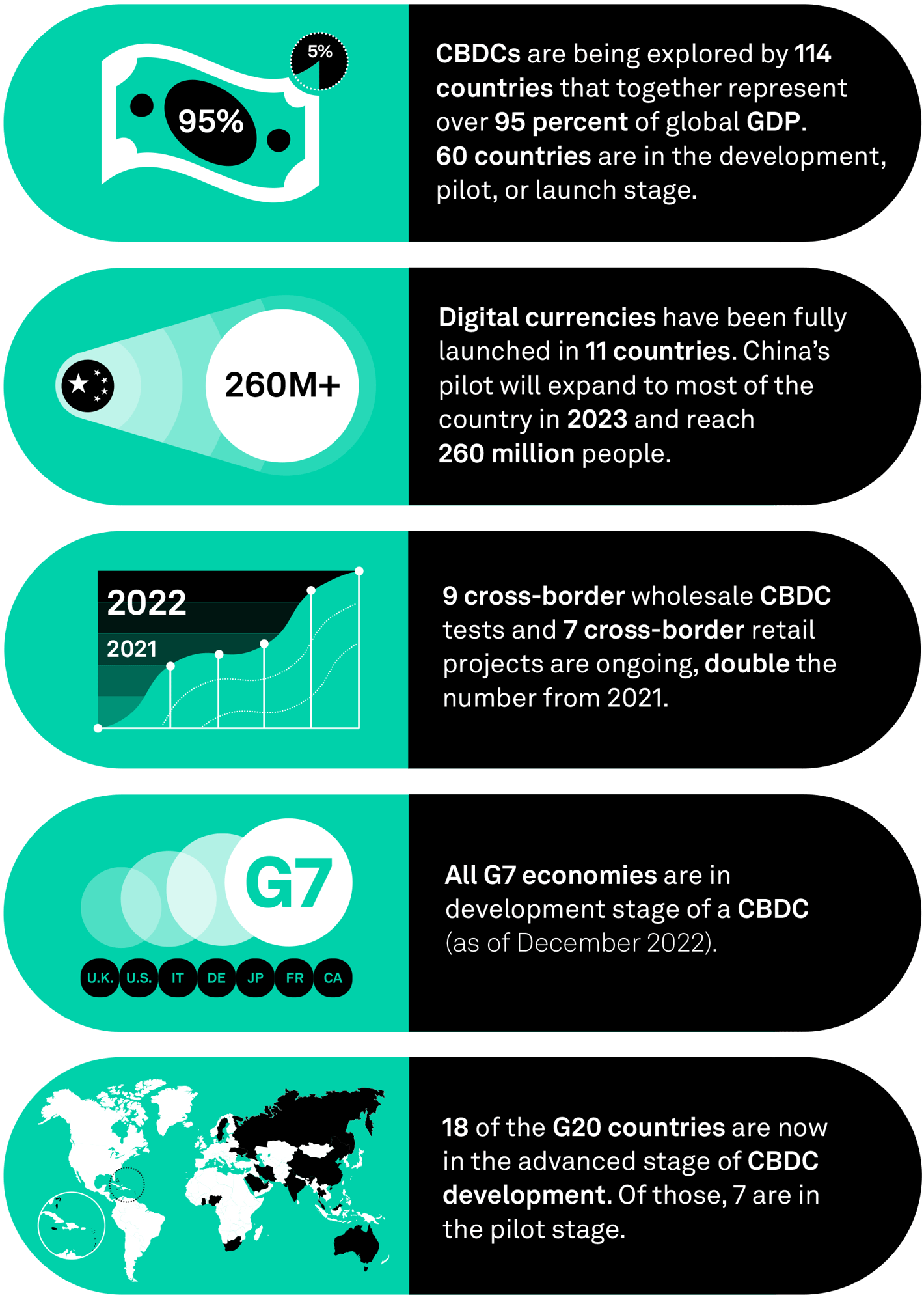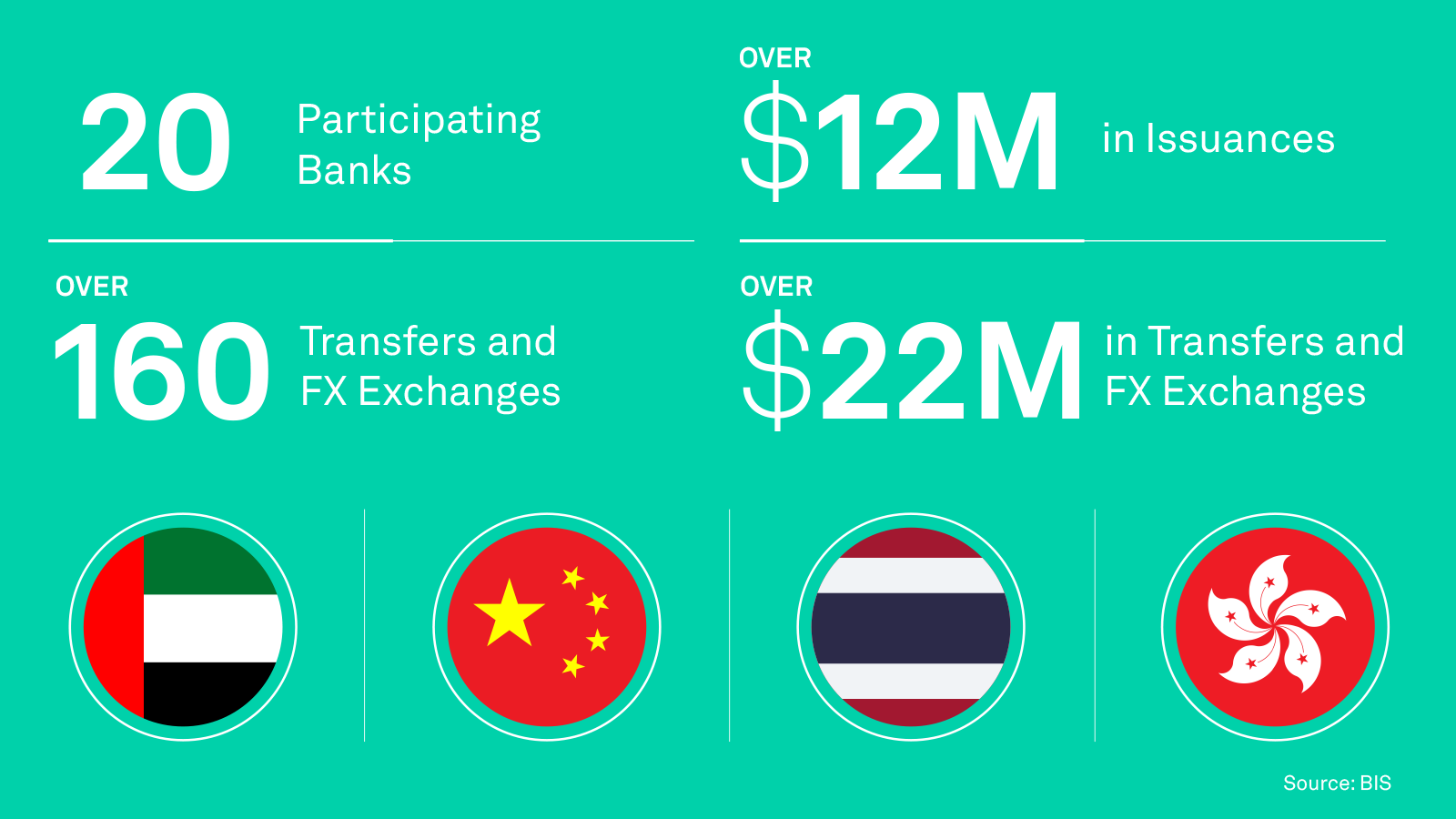What fintechs should know about Central Bank Digital Currencies

What are Central Bank Digital Currencies?
CBDCs (Central Bank Digital Currencies) are also known as digital cash. A CBDC is the digital version of a country’s currency, issued directly by the central bank in digital form. The public is able to access this central bank money as digital coins or tokens, or a digital account accessed through a personal device.
Although most money in the world is already moved around and stored in digital transactions, these involve deposits on accounts in commercial banks, who in turn hold deposits at the central bank. When we make digital payments via card or wallet, the merchants who accept the payment have to pay a fee to the commercial bank whose aim is to maximize profits, and all the parties in the clearing and settlement of the transaction also pay or receive fees.
In contrast, the central bank has a sole monopoly on the issuance of digital money and does not have a profit motive. So using CBDCs can reduce transaction costs and promote financial inclusion, as well as achieve other goals in line with the central bank’s oversight role. Most importantly, CBDCs are recognized by law and backed by the central bank, which cannot go bankrupt, unlike commercial banks which can fail and wipe out people’s savings.
Why central banks are in a rush to roll out CBDCs
Why are central banks in such a hurry to roll out their own digital currencies? Motivations vary between countries, but three are often mentioned by analysts. First is the rise of cryptocurrencies, crypto assets, and stablecoins. Central banks are concerned about the increasing activity in this volatile, unregulated market and the financial instability it brings. For example, during the COVID-19 pandemic, the crypto asset market exploded to 20 times its worth to $3 trillion in just a year and a half, and fell to less than $1 trillion within a 6-month period in 2022. Against this financial turmoil, central banks are keenly interested in wresting back control of the digital financial ecosystem and making sure that both digital and fiat money circulating within its borders complies with legal and regulatory safeguards.
The massive push for digital payments brought on by the pandemic is another factor, as more and more people saw the benefits of fast, secure and convenient money transfers without cash. With less cash being used, private sector solutions providing secure and risk-free digital payments began to increase in popularity, diminishing the role of the central bank, and in the case of cryptocurrencies, circumventing regulations.
It has also been observed that geopolitical motivations are driving some countries concerned about the key role of the US dollar in almost every central bank and financial institution in the world. Currently, 88 percent of all foreign exchange transactions involve the dollar. CBDCs may have the potential to settle currencies almost instantly across borders without any intermediate currencies being involved.
To summarize, CBDCs are being developed as an important anchor for central banks in the digital economy. They are the central banks’ answer to disruptive forces in the financial system by maintaining the public’s trust in government-issued money in the digital age. CBDCs also reinforce the central bank’s role of establishing and conducting monetary policy in a rapidly changing, interconnected financial ecosystem.
Fast Facts: CBDCs around the world

CBDCs, crypto assets and blockchain
The adoption of a CBDC will most likely bring new digital business models and additional opportunities to commercial banks and financial service providers for revenue and growth, similar to the way that roles and tasks are distributed today within the financial ecosystem. Who will be the disruptive and innovative players in this new ecosystem, though, remains to be seen.
Some financial institutions are investing in solutions revolving around crypto assets. There is speculation that the adoption of bitcoin as legal tender in countries like El Salvador and Central African Republic is a sign that crypto will play a role in government-backed financial initiatives. However, organizations such as the International Monetary Fund have expressed their opposition and criticism of crypto-based tender for many important reasons. The volatility of bitcoin means that it is difficult for governments to plan tax revenues, expenditures and economic activity around it. Lack of regulation means that there is no clear way of showing how much activity in cryptocurrency is related to illegal activity. For this reason, the vast majority of countries have rejected crypto assets as possible legal tender, preferring to develop their own digital currency.
Blockchain is another matter. Institutions such as the International Monetary Fund (IMF), the Bank for International Settlements (BIS), the Financial Stability Board (FSB) and major central banks around the world are showing interest in aspects of blockchain technology like permissioned ledgers that can be merged into existing regulatory framework. Potential applications are back office functions, cross-border payments, and trading. CBDCs could use permissioned ledger technology that preserve a consistent identity and make financial systems more secure. This is an attractive proposition that make CBDCs rival cryptocurrencies in their convenience, security and transferability while delivering the stability and integrity of fiat money.
What roles could fintechs and commercial banks play in the development of CBDCs?
1. Become an enabler of cross-border transactions. Blockchain technology and the fintechs who provide them may be called to participate in developing cross-border payments using CBDC. Cross-border payments are much more complicated than domestic payments, as different national currencies are involved, often existing in different legal and regulatory contexts. CBDCs of various countries could be exchanged in real-time on digital platforms. This could potentially be done very cheaply within a simpler banking relationship and benefit developing countries especially. At this moment, central banks are researching the feasibility of various models and investigating what kind of legacy problems need to be overcome. This would be an interesting area for fintechs to step in, either as an enabler of a blockchain-based system, or in developing or migrating to an innovative digital platform that could facilitate cross-border transactions with CBDC.
An example of this is a multi-CBDC platform known as mBridge, which experiments with cross-border payments. It is based on distributed ledger technology, a new kind of blockchain called the mBridge Ledger, which will allow different central banks to issue and exchange the CBDCs of their respective countries with each other. It is being developed by the BIS Innovation Hub Hong Kong Centre, the Hong Kong Monetary Authority, the Bank of Thailand, the Digital Currency Institute of the People's Bank of China and the Central Bank of the United Arab Emirates. In 2022, the platform was pronounced a success by BIS after it facilitated over $22 million in cross-border transactions with the involvement of 20 participating banks.

2. Enable payments interoperability and inclusivity. Along with the development and use of CBDCs, interoperability between payment methods is needed to avoid fragmentation. Fintechs could provide valuable consulting services, technological innovation and integration assistance to ensure that the domestic and global payment systems remain unified and inclusive.


3. Provide expertise in designing a CBDC that will be adopted and integrated into the current payments landscape. Many technologies such as distributed computing, distributed ledger, machine learning, predictive analytics are areas where fintechs can provide their expertise in the creation of CBDCs. The extensive experience of fintechs in this area can help central banks create financial products and services around CBDCs that are lower in cost and prove attractive from the end user’s point of view.
In some countries such as Jamaica, commercial banks are authorized to create CBDC accounts. Since CBDCs cannot be used to generate fees, there may not be a big incentive for their use. But commercial banks might explore embedding a CBDC account into a wallet where lots of additional services could be added as a source of revenue. It should be kept in mind that the role of commercial banks in CBDC is still yet to be clearly defined. But in any case, to make adoption of CBDCs worthwhile and not to be perceived as a threat to the traditional banking sector, it must be demonstrated that CBDCs will have tangible benefits for banks, payment players and non-financial institutions. Central banks will benefit from business cases and best practices from consumer-facing financial institutions to build CBDC solutions that will be widely adopted as soon as they are launched.


4. Provide innovation labs and technologies for experimentation with CBDC development. Central banks are teaming up with fintechs to experiment with existing digital infrastructure and services such as blockchain-as-a-service to pilot and launch prototype CBDCs. An example of this kind of collaboration is ConsenSys, a software company offering Ethereum-based blockchain solutions, and its work on CBDC pilot projects with the Reserve Bank of Australia, France’s Societe Generale, the Bank of Thailand, and the Hong Kong Monetary Authority. The company has launched the Codefi Payments Sandbox, which allows digital currency issuers to design and build infrastructure and build services around prototype CBDCs.

How banks, fintechs and non-bank fintechs can prepare for disruption
The impact of CBDCs on the domestic and global financial systems is still being observed and researched, and continues to attract speculation. Both financial and non-financial players in payments would do well to keep a close eye on CBDC developments in various regions, since they may have repercussions in multiple locations simultaneously. As central bank experts reach towards partnerships to build innovation, companies will benefit by an exchange of views, collaboration and knowledge sharing.
OpenWay, as a participant of the most recent G20 summit and a vendor serving tier 1 payment players across the globe, is watching development of CBDCs with keen interest. OpenWay’s Way4 digital payment software platform has anticipated many key payment features requested by central banks, commercial banks and non-bank fintechs in their prototype and testing of digital payment instruments. For example, Way4 Wallet can be used to manage various types of financial assets in one place, where digital and fiat assets may be integrated together in a unified view. OpenWay has helped clients develop financial inclusion solutions, enable 100% digital workflows, and integrate alternative payment methods with traditional payment rails. In whatever way CBDCs will impact our future financial system, OpenWay will continue to design and implement innovative solutions that promote collaboration, interoperability and security in the dynamic world of payments.
For further reading:
-
Lipsky, Josh, Kumar, Ananya. “It’s official: The United States is developing a bank-to-bank digital currency”. New Atlanticist, Atlantic Council. December 15, 2022. Accessed January 9, 2023.
-
Choueiri, Nada, Gulde-Wolf, Anne-Marie, Iyer, Tara. “Crypto is More in Line with Asian Equities, Highlighting the Need for Regulation”. International Monetary Fund blog, August 21, 2022.
-
Jones, Huw. “Pandemic pushes central bank digital currencies into top gear”. Reuters, June 11, 2020. Accessed January 9, 2023.
-
Demertzis, Maria. “Central Bank digital currencies as weapons of finance?” Bruegel, December 14, 2022. Accessed January 9, 2023.
-
“OTC foreign exchange turnover in April 2022 – Triennial Central Bank Survey”. BIS (Bank for International Settlements), October 27, 2022. Accessed January 9, 2023.
-
Denecker, Oliver, d’Estienne, Arnaud, Gompertz, Pierre-Matthieu, Sasia, Elia. “Central bank digital currencies: An active role for commercial banks”. McKinsey & Company, October 13, 2022. Accessed
-
Berman, Noah. “What Does the Cryptocurrency Decline Mean for Bitcoin Countries?” Council on Foreign Relations, December 21, 2022. Accessed January 9, 2023.
-
“Blockchain explained: What it is and isn’t, and why it matters”. Podcast. McKinsey & Company. September 28, 2018. Accessed January 9, 2023.
-
“Project mBridge: Connecting economies through CBDC”. BIS official website. Accessed January 9, 2023.
-
Takemiya, Makoto. “Cambodia’s digital currency can show other central banks the way”. World Economic Forum, August 30, 2021. Accessed January 9, 2023.
-
“BoE tenders for CBDC mobile wallet”. Central Banking Newsdesk, December 12, 2022. Accessed January 9, 2022
-
“Amazon, Nexi, Worldline, CaixaBank, EPI Join Digital Euro Project”. PYMNTS, September 16, 2022. Accessed January 9, 2022.